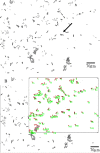Low-intensity red and infrared laser effects at high fluences on Escherichia coli cultures
- PMID: 26445339
- PMCID: PMC4617122
- DOI: 10.1590/1414-431X20154460
Low-intensity red and infrared laser effects at high fluences on Escherichia coli cultures
Abstract
Semiconductor laser devices are readily available and practical radiation sources providing wavelength tenability and high monochromaticity. Low-intensity red and near-infrared lasers are considered safe for use in clinical applications. However, adverse effects can occur via free radical generation, and the biological effects of these lasers from unusually high fluences or high doses have not yet been evaluated. Here, we evaluated the survival, filamentation induction and morphology of Escherichia coli cells deficient in repair of oxidative DNA lesions when exposed to low-intensity red and infrared lasers at unusually high fluences. Cultures of wild-type (AB1157), endonuclease III-deficient (JW1625-1), and endonuclease IV-deficient (JW2146-1) E. coli, in exponential and stationary growth phases, were exposed to red and infrared lasers (0, 250, 500, and 1000 J/cm2) to evaluate their survival rates, filamentation phenotype induction and cell morphologies. The results showed that low-intensity red and infrared lasers at high fluences are lethal, induce a filamentation phenotype, and alter the morphology of the E. coli cells. Low-intensity red and infrared lasers have potential to induce adverse effects on cells, whether used at unusually high fluences, or at high doses. Hence, there is a need to reinforce the importance of accurate dosimetry in therapeutic protocols.
Figures

References
-
- Niemz MH. Laser-tissue interactions: Fundamentals and applications. New York: Springer-Verlag; 2007.
-
- Karu TI, Lyapunova TS, Pomoshnikova NA. The activation of yeast metabolism with He-Ne laser radiation. IV. Relationship between the activity of catalase and protein synthesis. Lasers Life Sci. 1993;5:251–258.
-
- Karu T, Pyatibrat L. Gene expression under laser and light-emitting diodes radiation for modulation of cell adhesion: Possible applications for biotechnology. IUBMB Life. 2011;63:747–753. - PubMed
Publication types
MeSH terms
Substances
LinkOut - more resources
Full Text Sources

